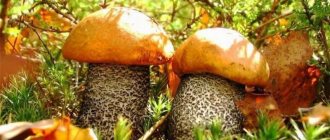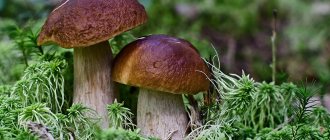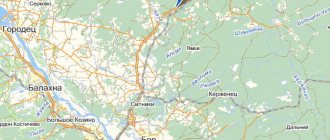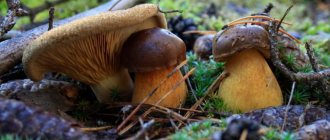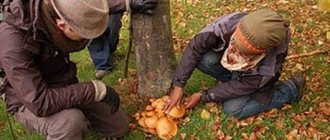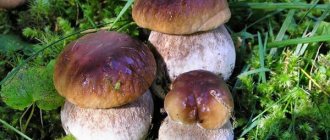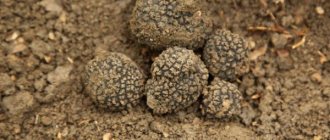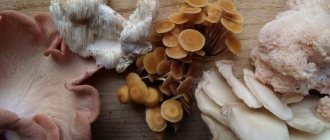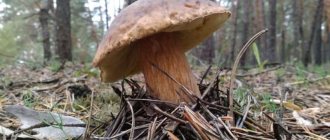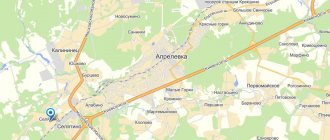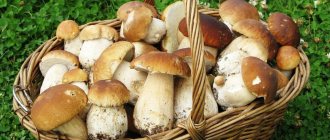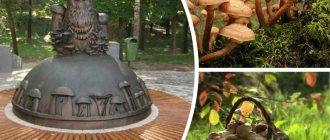Honey mushrooms always germinate in families, and unlike single mushrooms, they do not hide in the forest from mushroom pickers. If one clearing is found in the forest, then other fruits can be seen nearby. The most important thing is to go on a quiet hunt on time, using not only intuition and luck, but also important search criteria: weather forecast, map of mushroom places, GPS navigator and available tools necessary for collection. Well, to know for sure, “Are there mushrooms in the forest?”, it is worth learning more about the fruiting nature of the Kursk region in 2021.
In today’s article, we decided to tell our readers about the most important things, paying attention not only to places with edible and poisonous fruits, but also to real reviews from local residents telling about good catches in the new season.
Mushrooms area
Coat of arms and flag of the Kursk region
Traditionally, all mushrooms growing in the region and near the city of Kursk are divided into several groups:
- edible. They are eaten without fear and are not capable of causing negative health effects;
- conditionally edible, the use of which is advisable after proper processing, preparation and with caution. They are capable of accumulating heavy metals contained in the soil and can lead to poisoning;
- inedible, which can also lead to negative consequences, but not as serious as poisonous ones;
- poisonous. Absolutely, eating it will lead to a bad result, from gastrointestinal upset to death.
Representatives of each group occur in the region, so you need to know which specimens can be collected and eaten and which cannot.
Collection rules
When collecting, you should adhere to certain rules, which will help protect the mycelium from mechanical damage. A careful attitude will allow you to come back to your old place every year for a new portion of mushrooms.
When picking, mushrooms should not be pulled out, but rather cut with a knife. It is also allowed to unscrew each specimen from the mycelium by turning it around its axis. Among the family, it is worth selecting only young mushrooms, since the spongy pulp of overgrown ones can accumulate harmful toxins.
Picked mushrooms should first be cleared of grass and soil, and then placed in a basket with their caps up or on their side.
Important! To spread spores, it is worth hanging overgrown specimens on tree branches.
Edible
Among the mushrooms that are consumed and eaten in the Kursk region, there are many well-known ones.
Porcini
Porcini
It is distinguished by its large size, fleshy structure, and wide stem, similar to a barrel. The cap is large, brown, tubular. The smell is pleasant, mushroom.
Suitable for making soup, baking, frying, stewing in sour cream sauce, etc. Often used to dry and prepare mushroom powder, which adds flavor to the dish.
Honey mushrooms
Meadow mushrooms
They grow in areas with high humidity, on stumps, near trees, and meadows in groups. They have a thin long stem, brown or yellowish color. The hat is semicircular or umbrella-shaped. It varies depending on the “age” of the mushroom.
The size of honey mushrooms is small, the flesh is tender with a pleasant smell. Many varieties have a “skirt”, which is mistakenly mistaken for an unambiguous symbol of a poisonous specimen. Preparation can be varied: from frying to salting or pickling for the winter.
Honey mushrooms are easily confused with false ones. The latter do not have scales on the cap, a “skirt” on the leg, with a grayish or brownish tint. The smell of poisonous representatives of the species resembles rotten wood.
Russula
They are often mistaken for dangerous due to the bright color of their caps. It can be red, purple, yellow and even green. The cap has a dense structure; the skin can be easily removed from the plates. The leg is strong, smooth, white. They are eaten salted, pickled, fried, etc.
Expert opinion
Gennady Sergeevich Rylov
A great expert in mycology and an avid mushroom picker. Knows everything about mushrooms, their types and places of growth
The mushroom pulp may be slightly bitter, so it is recommended to soak it in salted water and cook for 10 minutes.
If the mushroom has too bitter flesh, it is better not to eat it. Bitterness can cause gastrointestinal problems and vomiting. They grow in plantings and forests.
Russula Food
Soap row
Rows
Usually small with a dense stalk of dark gray or brown color. The beauty of this species is that once you find one specimen, there will definitely be several more nearby.
They do not sprout one at a time, but form a chain or row, which is where they get their name. They grow 3-5 m from planting along the entire length.
Autumn oyster mushroom
Oyster mushrooms
Grows on fallen, old, rotten trees and stumps in plantings and forests. Difficult to confuse with other mushrooms. It has a pleasant smell, is strong, grows in groups.
You can fill a whole basket from one place. The structure is dense, the stem is almost absent, the cap is uniform, gray in color, and resembles a shell in shape.
Butter
They have a smooth, oily cap of dark brown color. The leg is small and dense. Does not reach large sizes.
The flesh is soft like a sponge. They grow in coniferous forests or near them; they are not found in deciduous forests. You can prepare it in different ways: from frying to salting.
Real oil can
Will winter mushrooms grow in 2022 in the Kursk region? Photo with mushroom map
Abnormally warm winters in recent years are ideal for honey mushrooms to bear fruit. Temperatures from 0 degrees and warmer allow families to grow in deciduous forests where there are clearings and rotten stumps. The bright orange mushrooms can bear fruit on the bark and roots, standing out among the snow-white landscape.
Fruiting occurs annually from December to February, until the temperature drops to 5 degrees below zero. Sub-zero weather stops growth, but allows you to continue collecting already frozen fruits.
Inedible
You should not try such specimens; it may end in nothing for the taster, and can lead to serious consequences for life and health. Such mushrooms are called either inedible or conditionally edible, and eating them is associated with great risks. Some experts classify them as poisonous.
You should not eat mushrooms with alcohol; this combination significantly increases the risk of poisoning.
False honey fungus
False honey mushrooms
It strongly resembles its edible counterpart, but does not have a skirt, the cap is slightly different in color, and lacks the characteristic scales. The cut does not change color, it remains the original color.
When consumed, vomiting, stool disorders, and dehydration occur. No deaths have been recorded, but the blow to health is severe.
Fat pig
pigs
Previously considered edible, but now it has been proven that it contains substances that accumulate in the body and disrupt kidney function. The cap is dark brown, smooth, velvety, reaches 5 cm.
Grows in forests and forest plantations. It has a bitter taste, which is why it used to be soaked.
Russula emetic
It is almost impossible to distinguish from an edible specimen. The only difference is the strong bitter taste of the pulp. It is impossible to eat such a mushroom; it is tasteless. This is why poisoning rarely occurs.
Russula emetic
Bile mushroom
Bile or false white
Outwardly it looks like a noble white mushroom, but the taste of the flesh is so bitter that it is impossible to eat. What gives it away is that the edible brother often has worms, but the inedible one never does. When consumed, there is a negative effect on the liver.
Poisonous species
The Kursk region also has an abundance of dangerous species of mushrooms. They cannot be eaten in any form, otherwise complications will include severe poisoning, hallucinations, and death.
fly agaric
fly agaric
It has a characteristic bright red cap color with white splashes. The leg is high and smooth.
They grow singly and in several nearby. Eating is strictly forbidden, as it can cause dizziness, hallucinations, gastrointestinal upset, and death.
Toadstool pale
Toadstool pale
It is considered the most dangerous and poisonous mushroom of all growing in Russia. Outwardly, for an inexperienced mushroom picker, it resembles a champignon.
The main features of the toadstool are white plates under the cap, a thin stalk, the cap itself is white or with shades of green, the presence of a volva from which the mushroom grows and a skirt on the stalk.
The toadstool leads to death even if ¼ of the cap gets into food. It is difficult to save a person, and if you are lucky enough to survive, the consequences of poisoning will remain forever.
Gray dung beetle
The appearance immediately suggests poisonousness, but some inexperienced mushroom pickers still decide to try it. It looks like an umbrella with a thin gray cap covered with scales. Grows on a thin long stalk in groups. Consumption is associated with the risk of poisoning and intoxication with serious consequences.
Gray dung beetle
Necessary things in the forest
When going to the forest to collect the harvest, you should definitely take:
Knife. It is needed for cutting crops. Under no circumstances should you simply break or pick off mushrooms. This can damage the mycelium, and they will no longer grow here.- A basket or basket. Experts recommend collecting mushrooms in baskets, as they are preserved longer due to ventilation. The bags do not allow air to pass through, and the mushrooms quickly perish.
- A stick. When looking for mushrooms in the grass or foliage, use it; you don’t have to look with your hands, you might get a tick or a snake bite, and there may also be broken glass in the grass.
These simple things will help you pick mushrooms and protect you from various troubles.
So, in October, feel free to go to the forest to replenish your mushroom supplies. Don't forget about safety and collection rules. Then tasty and aromatic mushrooms on your table will delight your family and guests all long winter.
Mushroom places
Experts believe that there is no need to look for a mushroom, it is important to find a place where there are a lot of them and remember it. If cut correctly in the same area, it will appear again every year. The region has the following mushroom areas:
- October;
- Zheleznogorsk;
- Kursk;
- Dmitrievsky;
- Sudzhansky;
- Oboyansky.
An abundance of mushrooms grow there depending on the season; you need to look for them near Vanino, Shchigra, Khalino, Klyukva.
Application
You can make a lot of things from mushrooms. For example, pickle or marinate. Some people eat them raw.
Carefully check the information about which specimens are prohibited from being consumed without prior processing.
Can be fried, boiled. You can find a huge number of recipes for any mushroom on the Internet. However, it is important to read them carefully, so that later it turns out that the product is spoiled and the work was wasted, and there is no one to ask.
The most popular for cooking are white ones. Many mushroom pickers even grow them themselves at home.
On an industrial scale, a direction has been taken in winemaking, baking and the production of fermented milk products, where microscopic in size, but extremely important for humans, mushrooms are used. In addition, medicine actively uses mushrooms in the medicinal industry, some of them are used in the creation of antibiotics.
What is collected in spring, summer and autumn
The abundance of mushrooms in the Kursk region and the city of Kursk allows you to collect them all year round. There are even winter representatives, for example, honey mushrooms. The table provides information on types and timing of collection:
| Season. | Mushrooms. |
| Summer (June-August). | Honey mushrooms, white mushrooms, champignons, chanterelles. |
| Autumn (September-November), mainly in September. | Honey mushrooms, rows, white, russula, raincoat. |
| Winter (December-February). | Winter honey mushrooms, oyster mushrooms. |
| Spring (March-May). | Morels, spring oyster mushrooms. |
In addition to these, other species may occur, but these are the most widespread. A variety of mushrooms grow in the region.
There are representatives of edible, dangerous and relatively edible species. The collection is carried out taking into account the characteristics of the season and with the participation of experienced mushroom pickers who know well what to put in the basket.
Advice from experienced mushroom pickers
It is best to cut mushrooms early in the morning, while there is no slanting sunlight. Mushrooms collected at this time are fresh, dense and more stable during storage. Mushrooms are often found along forest paths and roads. Therefore, if the forest is unfamiliar, it is better not to go into the depths. Do not pick mushrooms in urban areas, near industrial enterprises, railways and highways. By collecting mushrooms there, you will have a chance to introduce your body to the entire periodic table. You should not collect old, overripe or very young mushrooms whose morphological characteristics are not clearly defined.
Additional material: Galerina bordered: how to distinguish from honey mushrooms
